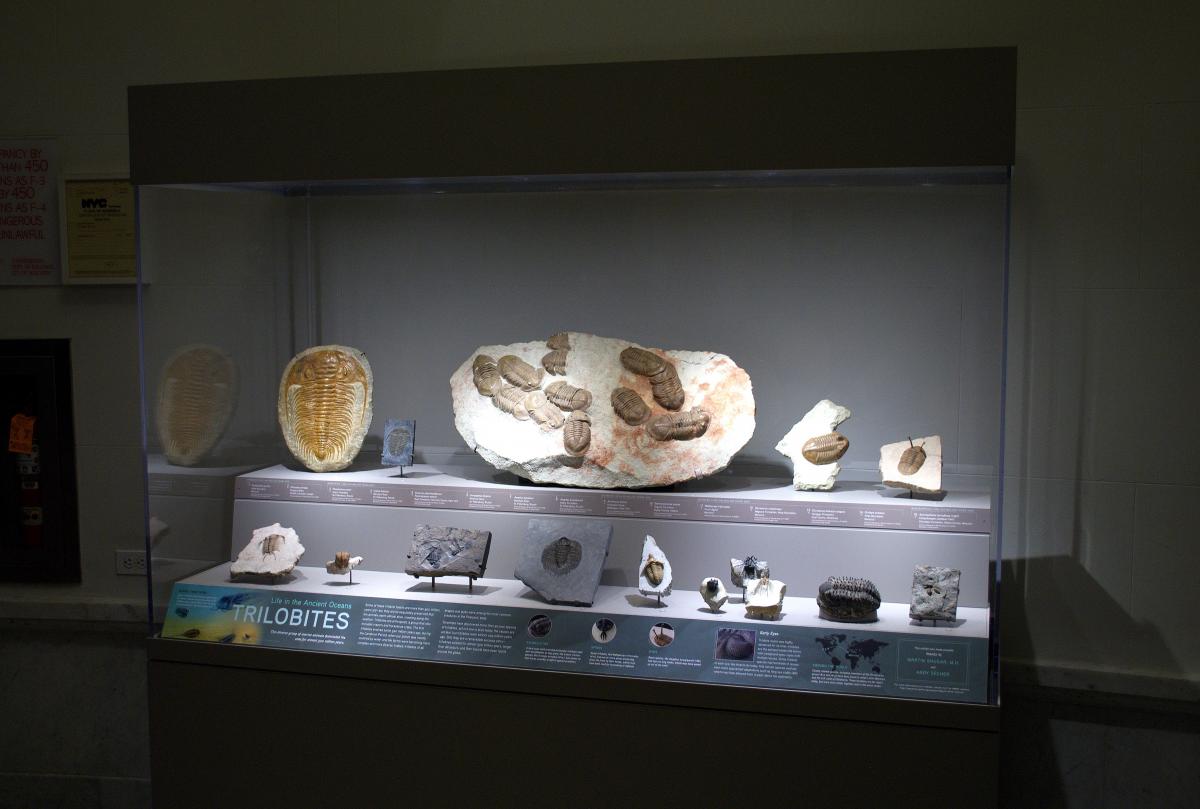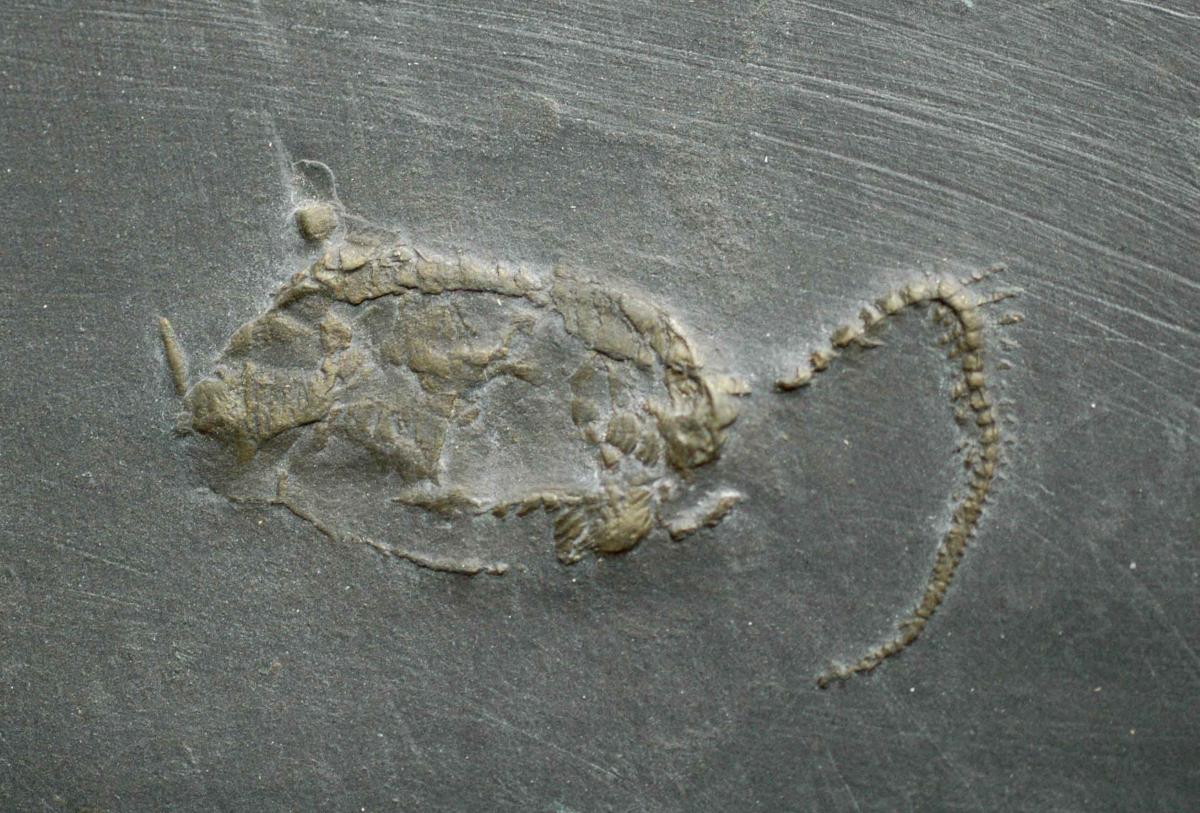Last week, I unleashed my inner Ansel Adams and gave you a dramatically lit fossil with distinct ridges. What was it?
 A trilobite, of course! Trilobites are arthropods, making them close cousins (evolutionarily speaking) to living groups such as insects, crustaceans, and spiders. They first appeared, complex eyes and all, around the Cambrian “explosion” about 521 million years ago. Paleontologists are confident, however, that their true origin was in the Precambrian. The American Museum of Natural History has a lovely corner of their webpage devoted to trilobites. The Introduction page was clearly written by a paleontologist who moonlights as a poet:
A trilobite, of course! Trilobites are arthropods, making them close cousins (evolutionarily speaking) to living groups such as insects, crustaceans, and spiders. They first appeared, complex eyes and all, around the Cambrian “explosion” about 521 million years ago. Paleontologists are confident, however, that their true origin was in the Precambrian. The American Museum of Natural History has a lovely corner of their webpage devoted to trilobites. The Introduction page was clearly written by a paleontologist who moonlights as a poet:
Though their true origins remain shrouded in Precambrian mystery, there can be little doubt that the root stock of the trilobite lineage stretches well back into that poorly understood period of our planet's early history. Yet as soon as their remains started filling the fossil record at the dawn of the hallowed Cambrian Explosion, trilobites were already the unquestioned kings of the Earth's primordial seas. These strangely beautiful creatures—named not for their distinctive cephalon, thorax and pygidium (head, body, tail), but rather for the three lobes that divide their lateral symmetry—would eventually evolve into more than 20,000 scientifically recognized species and dominate the world's oceans for the next quarter of a billion years.
 Trilobites are just cool. They vary in size from tiny to holy-moly enormous, some rolled up like modern-day pill bugs, and some had crazy horn-like things. But more than just cool, trilobites are extra important to paleontology because they have a specific trifecta of characteristics: they are found globally, they are numerous, and they are diverse. These characteristics make trilobites ideal index fossils. Index fossils are distinctive fossils used to compare and establish the relative ages of rocks around the world. Overall, trilobites are present in over 270 million years of Earth’s history (from about 521–250 million years ago), but each of the 20,000+ species of trilobite are present for just a sliver of that time. So if you find Trilobite A in a layer of shale in Italy but not in the layers above or below, then when you find Trilobite A in a layer of shale in Pennsylvania, you know that those rocks are the same age as their Italian counterparts. Cool, right? And as you learned in a previous post, you can’t date fossils directly, but with some directly dateable igneous rocks thrown into the mix, we can put together a nice timeline using this kind of correlation. Helping the cause is the fact that trilobites, like most living arthropods, molted. Every shed exoskeleton was another opportunity for fossilization.
Trilobites are just cool. They vary in size from tiny to holy-moly enormous, some rolled up like modern-day pill bugs, and some had crazy horn-like things. But more than just cool, trilobites are extra important to paleontology because they have a specific trifecta of characteristics: they are found globally, they are numerous, and they are diverse. These characteristics make trilobites ideal index fossils. Index fossils are distinctive fossils used to compare and establish the relative ages of rocks around the world. Overall, trilobites are present in over 270 million years of Earth’s history (from about 521–250 million years ago), but each of the 20,000+ species of trilobite are present for just a sliver of that time. So if you find Trilobite A in a layer of shale in Italy but not in the layers above or below, then when you find Trilobite A in a layer of shale in Pennsylvania, you know that those rocks are the same age as their Italian counterparts. Cool, right? And as you learned in a previous post, you can’t date fossils directly, but with some directly dateable igneous rocks thrown into the mix, we can put together a nice timeline using this kind of correlation. Helping the cause is the fact that trilobites, like most living arthropods, molted. Every shed exoskeleton was another opportunity for fossilization.
This particular trilobite is a Chotecops ferdinandi (formerly Phacops ferdinandi) from the Hunsrück slate in Germany, famous for its exceptional preservation of Devonian fauna. And if you’re in the Hunsrück slate, you’re going to see a lot of these guys: they’re said to be the most common macrofossil there. Fossils from Hunsrück are  extra cool because they have been pyritized—which, sadly, doesn’t mean they got hooks and eye patches, but it does mean that the organic material was replaced with the mineral pyrite. Pyritization is rare in the fossil record, and occurs when sulfur and iron are present in an anoxic (no-oxygen) environment. Unfortunately, the fool’s golden color of pyrite isn’t as obvious in this specimen as it is in some others, such as this echinoderm from the same locality.
extra cool because they have been pyritized—which, sadly, doesn’t mean they got hooks and eye patches, but it does mean that the organic material was replaced with the mineral pyrite. Pyritization is rare in the fossil record, and occurs when sulfur and iron are present in an anoxic (no-oxygen) environment. Unfortunately, the fool’s golden color of pyrite isn’t as obvious in this specimen as it is in some others, such as this echinoderm from the same locality.
Congratulations to Dan Phelps, who got the genus AND locality, and to John Harshman who set him on the right path with the correct genus. I am most impressed, sirs! My hat off to you.
Are you a teacher and want to tell us about an amazing free resource? Do you have an idea for a Misconception Monday or other type of post? See some good or bad examples of science communication lately? Drop me an email or shoot me a tweet @keeps3.

